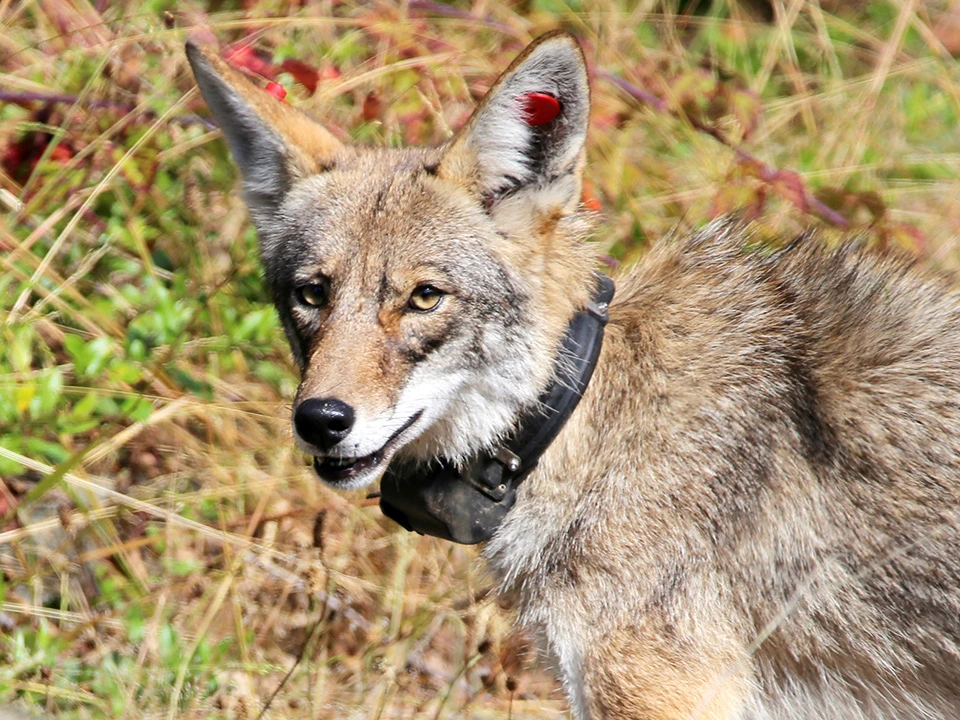Last updated: October 11, 2024
Article
Coyote Tracking in the Marin Headlands

Presidio Trust
Importance:
Coyotes are key predators in park ecosystems. People feeding them erodes visitor and coyote safety.
Coyotes are native to the Bay Area and throughout North America. As top-level carnivores, they play an important role in regulating the number of mesocarnivores, like skunks and raccoons, as well as many small rodents. In short, they help to maintain balanced, biodiverse ecosystems. Coyotes in Golden Gate National Parks can be found in close proximity to human development, presenting unique challenges for promoting visitor safety and coyote conservation.
The park continues to see issues with people feeding coyotes across Marin, particularly in the Marin Headlands. When fed, wild animals like coyotes quickly learn to associate people with food, and can exhibit aggressive behavior. Food-conditioned coyotes also spend more time along roads, increasing their chances of being hit by cars.
Coyotes are difficult to study through direct observation. Much is still unknown about the ecology, population structure, genetics, and behavior of Marin coyotes, and how these factors are affected by human actions and urban development.
The Project:
Beginning fall 2020 and continuing for the next three years, National Park Service wildlife biologists will use temporary remote tracking collars to learn about the population size and movements of coyotes in the Marin Headlands.
Scientists in the Presidio have used remote tracking collars to understand the population size and movements of coyotes in San Francisco. Park biologists are now using a similar approach to learn about coyotes in the Marin Headlands. The park will use this information to proactively address problems with food-seeking coyotes, and protect the safety of both park visitors and wildlife.
Park scientists will be partnering with the Presidio Trust and UC-Davis for this project, enabling widespread coyote tracking across different areas in the San Francisco Bay Area. This collaboration will provide a more regional picture of coyote ecology and movement patterns, and more support for research on coyote diet, genetics, and social structure.
Research Objectives:
Tracking coyotes will help build a stronger understanding of how they are using park lands and responding to human behavior. It will inform targeted community outreach and management actions that protect visitor and coyote safety.
- Map coyote locations and movement patterns across park lands
- Collect data on coyote abundance, diet, population structure and genetics, disease exposure, and ecology
- Compare coyote behavior and movements between more developed versus wild park lands
- Inform targeted community outreach for reducing coyote feeding and human-coyote encounters
- Monitor coyote behavior and movements before and after community outreach and management actions
Participate in Community Science and Help Keep Wildlife Wild!
To prevent future bites or the need to euthanize a coyote, we ask the public not to feed or approach animals in the park.
- Animals that are fed by humans lose their natural fear and their ability to forage on their own. They often become overly aggressive and completely dependent on handouts. Please keep the “wild” in wildlife and don’t feed wild animals. More information about wildlife viewing at Golden Gate National Recreation Area is on the park’s website.
- If you see a coyote with a satellite collar and colored ear tags, please take a picture and report your observation to our iNaturalist project or email park wildlife ecologist Bill Merkle. However, keep in mind that even approaching a coyote for a photo opportunity can encourage habituated behavior. Please maintain a generous distance at all times to help keep coyotes safe. Telephoto lenses are a great way to capture photos of wildlife from a safe distance.
- Visitors should continue to report coyote encounters and people feeding coyotes to non-emergency park dispatch at 415-561-5505
Additional Resources
Explore our iNaturalist Project: Tracking Coyotes in Marin
Golden Gate National Recreation Area:
Natural Resource Management
Mammals
Wildlife Viewing Guidelines
Coyotes
Presidio Trust: Coyotes in the Presidio
Project Coyote: Promoting Coexistence between people and wildlife
Summary written by Maritte O’Gallagher, August 2020.
